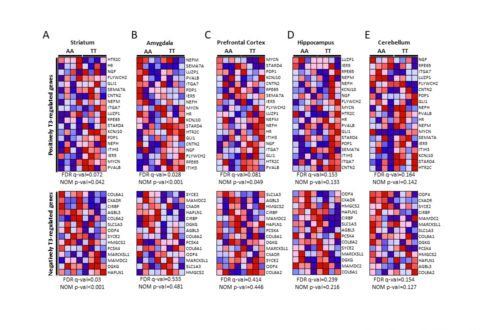Levothyroxine (L-T4) is a form of thyroid hormone used to treat hypothyroidism. In the brain, T4 is converted to the active form T3 by the type 2 deiodinase (D2). Thus, it is intriguing that carriers of the Thr92Ala polymorphism in the D2 gene (DIO2) exhibited clinical improvement when liothyronine (L-T3) was added to L-T4 therapy. Here we report that D2 is a cargo protein in endoplasmic reticulum Golgi intermediary compartment (ERGIC) vesicles, recycling between ER and Golgi. The Thr92 to Ala substitution (Ala92-D2) causes ER stress and activates the unfolded protein response (UPR); Ala92-D2 accumulates in the trans-Golgi and generates less T3, all of which is restored by eliminating ER stress with the chemical chaperone 4-phenyl butyric acid (4-PBA). An Ala92-Dio2 polymorphism-carrying mouse exhibits UPR and hypothyroidism in distinct brain areas. The mouse refrains from physical activity, sleeps more and requires additional time to memorize objects. Enhancing T3 signaling in the brain with L-T3 improves cognition, whereas restoring proteostasis with 4-PBA eliminates the Ala92-Dio2 phenotype. In contrast, primary hypothyroidism intensifies the Ala92-Dio2 phenotype, with only partial response to L-T4 therapy. Disruption of cellular proteostasis and reduced Ala92-D2 activity may explain the failure of L-T4 therapy in carriers of Thr92Ala-DIO2.
A deiodinase polymorphism causes ER-stress and hypothyroidism in the brain.
Sungro Jo1, Tatiana L. Fonseca, Barbara M. L. C. Bocco, Gustavo W. Fernandes, Elizabeth A. McAninch, Anaysa P. Bolin, Rodrigo R. Da Conceição, Joao Pedro W. S. De Castro, Daniele L. Ignacio, Péter Egri, Dorottya Németh, Csaba Fekete, Maria Martha Bernardi, Victoria D. Leitch, Naila S. Mannan, Katharine F. Curry, Natalie C. Butterfield, J. H. Duncan Bassett, Graham R. Williams, Balázs Gereben, Miriam O. Ribeiro, Antonio C. Bianco JCI. 2018 Oct in press. PMID: 30352046
